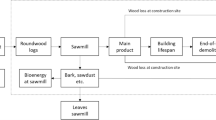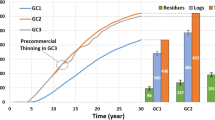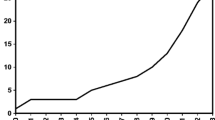Abstract
Purpose
There are many recent proposals in life cycle assessment (LCA) to calculate temporary storage of carbon in bio-based products. However, there is still no consensus on how to deal with the issue. The main questions are: how do these proposals relate to each other, to what extent are they in line with the classical LCA method (as defined in ISO 14044) and the global mass balances as proposed by the IPCC, and is there really a need to introduce a discounting system for delayed CO2 emissions?
Methods
This paper starts with an analysis of the widely applied specification of PAS 2050 and the ILCD Handbook, both specifying the credit for carbon sequestration as ‘optional’ in LCA. From this analysis, it is concluded that these optional calculations give rather different results compared to the baseline LCA method. Since these optional calculations are not fully in line with the global carbon mass balances, a new calculation method is proposed. To validate the new method, two cases (one on wood and one bamboo products) are given. These cases show the practical application and the consequences of the new approach. Finally, the main issue is evaluated and discussed: is it a realistic approach to allocate less damage to the same emission, when it is released later in time?
Results and discussion
This paper proposes a new approach based on the global carbon cycle and land-use change, translated to the level of individual products in LCA. It is argued that only a global growth of forest area and a global growth of application of wood in the building industry contribute to extra carbon sequestration, which might be allocated as a credit to the total market of wood products in LCA. This approach is different from approaches where temporary storage of carbon in trees is directly allocated to a product itself.
Conclusions
In the proposed approach, there seems to be no need for a discounting system of delayed CO2 emissions. The advantage of wood and wood-based products can be described in terms of land-use change on a global scale in combination with a credit for heat recovery at the end-of-life (if applicable).







Similar content being viewed by others
Notes
The new ISO 14067 specifies that the calculation has to be done ‘without the effect of timing’; however, the effect of timing may be included in a separate report (section 6.3.8)
Besides the trunks, branches, and shrub, there is CO2 stored below ground in the soil and roots of a plantation. Zhou and Jiang (2004) found that, for a medium intensity managed Moso bamboo plantation in Lin'an, Zhejiang province, the distribution of biomass above ground versus below ground is 32.2 and 68.8 %, respectively.
Here is a similar argumentation as in footnote 2 for European wood. It must be mentioned here that this growth does not require extra agricultural land. Much of the bamboo production in the past comes from better forest management (Lou et al. 2010). Moreover, bamboo is planted in areas where farming is not feasible, e.g., at slopes for erosion prevention, and for rehabilitating land (Kuehl Y et al. 2011)
References
Aalde H, Gonzalez P, Gytarsky M, Krug T, Kurz WA, Ogle S, Raison J, Schoene D, Ravindranath NH, Elhassan NG, Heath LS, Higuchi N, Kainja S, Matsumoto M, Sánchez MJS, Somogyi Z (2006) IPCC Guidelines for National Greenhouse Gas Inventories. Volume 4, Chapter 4 Forest Land. Available at www.ipcc.ch. Accessed 6 Feb 2013
Brandao M, Levasseur A (2011) Assessing temporary carbon storage in life cycle assessment and carbon foot printing: outcomes of an expert workshop JRC 63225. Publications Office of the European Union, Luxembourg
Brandao M, Levasseur A, Kirschbaum MUF, Weidema BP, Cowie AL, Vedel Jørgensen S, Hauschild MZ, Pennington DW, Chomkhamsri K (2013) Key issues and options in accounting for carbon sequestration and temporary storage in life cycle assessment and carbon footprinting. Int J Life Cycle Assess 18(1):230–240
BSI, British Standards Institution (2011) PAS 2050: 2011 Specification for the assessment of the life cycle greenhouse gas emissions of goods and services. BSI, London
Cherubini F, Bright RM, Strømman AH (2012) Site-specific global warming potentials of biogenic CO2 for bioenergy: contributions from carbon fluxes and albedo dynamics. Environ Res Lett 7:045902. doi:10.1088/1748-9326/7/4/045902
Clift R, Brandão M (2008) Carbon storage and timing of emissions. University of Surrey. Centre for Environmental Strategy Working. Paper Number 02/08. ISSN: 1464–8083, Guildford
CSF (2013) website Chinese State Forestry, http://english.forestry.gov.cn/web/index.do. Accessed 6 Feb 2013
European Commission–Joint Research Centre and Institute for Environment and Sustainability (2010) International reference life cycle data system (ILCD) handbook—general guide for life cycle assessment—detailed guidance. Publications Office of the European Union, Luxembourg
FAO (2010) Global forests resources assessment, Forestry Paper 163. Food and Agriculture Organisation of the United Nations, FAO. Available at www.fao.org/forestry. Accessed 6 Feb 2013
Fearnside PM, Lashof DA, Moura-Costa P (2000) Accounting for time in mitigating global warming through land-use change and forestry. Mitig Adapt Strateg Glob Chang 5:239–270
Finkbeiner M (2009) Carbon footprinting—opportunities and threats. Int J Life Cycle Assess 14(2):91–94
Hischier R, Weidema B, Althaus H-J, Bauer C, Doka G, Dones R, Frischknecht R, Hellweg S, Humbert S, Jungbluth N, Köllner T, Loerincik Y, Margni M, Nemecek T (2010) Implementation of life cycle impact assessment methods. Ecoinvent report No. 3, v2.2. Swiss Centre for Life Cycle Inventories, Dübendorf
IEA (2007) Biomass for Power Generation and CHP. Available at https://www.iea.org/techno/essentials3.pdf. Accessed 6 Feb 2013
Kendall A (2012) Time-adjusted global warming potentials for LCA and carbon footprints. Int J Life Cycle Assess 17:1042–1049
Kuehl Y, Henley G, Lou Y (2011) The climate change challenge and bamboo: mitigation and adaptation. IMBAR, Beijing. Available at http://www.inbar.int/publications/?category=1&sortby=title&dlpage=4. Accessed 6 Feb 2013
Levasseur A, Lesage P, Margni M, Deschenes L, Samson R (2010) Considering time in LCA: Dynamic LCA and its application to global warming impact assessments. Environ Sci Technol 44(8):3169–3174
Levasseur A, Lesage P, Margni M, Samson R (2013) Biogenic carbon and temporary storage addressed with dynamic life cycle assessment. J Ind Ecol 17(1):117–128
Lou Y, Li Y, Buckingham K, Henley G, Zhou G (2010) Bamboo and Climate Change Mitigation. IMBAR, Beijing. Available at http://www.inbar.int/publications/?category=2. Accessed 6 Feb 2013
Solomon S, Qin D, Manning M, Chen Z, Marquis M, Averyt KB, Tignor M, Miller HL (2007) IPCC Fourth Assessment Report: Climate Change (AR4), The Physical Science Basis, Contribution of Working Group I to the Fourth Assessment Report of the Intergovernmental Panel on Climate Change, Cambridge University Press, Cambridge. Available at www.ipcc.ch. Accessed 6 Feb 2013
UNECE, United Nation Economic Commission for Europe (2005) European Forest Sector Outlook Study 1960-2000-2020, Geneva Timber and Forest Study Paper 20. Available at http://www.unece.org/forests-welcome/publications.html. Accessed 6 Feb 2013
Van der Lugt P, Vogtländer J, Brezet J (2009) Bamboo a sustainable solution for Western Europe. VSSD, Delft
Verchot L, Krug T, Lasco RD, Ogle S, Raison J, Yue Li, Martino DL, McConkey BG, Smith P (2006) IPCC guidelines for national greenhouse gas inventories. Volume 4, Chapter 6 Grass Land. Available at www.ipcc.ch. Accessed 6 Feb 2013.
Vogtländer J, Brezet J, Hendriks CF (2001) The Virtual Eco-costs '99, a single LCA-based indicator for sustainability and the Eco-costs/Value Ratio (EVR) model for economic allocation. Int J Life Cycle Assess 6(3):157–166
Vogtländer JG, Lindeijer E, Witte J-PM, Hendriks C (2004) Chacterizing the change of land-use based on Flora: application for EIA and LCA. J Clean Prod 12:47–57
Vogtländer J, Van der Lugt P, Brezet J (2010) The sustainability of bamboo products for local and Western European applications LCAs and land-use. J Clean Prod 18:1260–1269
Vogtländer J (2010) A practical guide to LCA for students, designers and business managers, cradle-to-grave and cradle-to-cradle. VSSD, Delft
Werner F, Althaus H-J, Künninger T, Richter K, Jungbluth N (2007) Life cycle inventories of wood as fuel and construction material. Ecoinvent Report No. 9. Swiss Centre for Life Cycle Inventories, Dübendorf
Zhou GM, Jiang PK (2004) Density, storage and spatial distribution of carbon in Phyllostachys pubescens forest. Sci Silvae Sin 6:20–24 (in Chinese with English summary)
Author information
Authors and Affiliations
Corresponding author
Additional information
Responsible editor: Matthias Finkbeiner
Rights and permissions
About this article
Cite this article
Vogtländer, J.G., van der Velden, N.M. & van der Lugt, P. Carbon sequestration in LCA, a proposal for a new approach based on the global carbon cycle; cases on wood and on bamboo. Int J Life Cycle Assess 19, 13–23 (2014). https://doi.org/10.1007/s11367-013-0629-6
Received:
Accepted:
Published:
Issue Date:
DOI: https://doi.org/10.1007/s11367-013-0629-6




